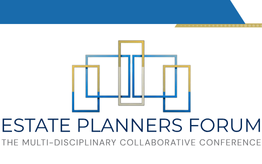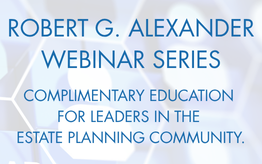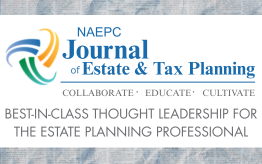September, 2024 Newsletter
Provided by Leimberg Information Services
See other issues.
Paul Hood & John Warnick: A Wake-Up Call to the Estate Planning Advisory Community
Paul Hood and John Warnick provide members with commentary that examines the current state and the future of estate planning.
A native of Louisiana (and a double LSU Tiger), Paul Hood obtained his undergraduate and law degrees from Louisiana State University and an LL.M. in taxation from Georgetown University Law Center before settling down to practice tax and estate planning law in the New Orleans area. Paul has taught at the University of New Orleans, Northeastern University, The University of Toledo College of Law and Ohio Northern University Pettit College of Law. Paul has authored or co-authored nine books, including his most recent book, Yours, Mine & Ours: Estate Planning for People in Blended or Stepfamilies and hundreds of professional articles on estate and tax planning and business valuation. He can be contacted at paul@paulhoodservices.com.
“John A” Warnick John A. Warnick graduated with honors with a J.D. from George Washington University Law School in 1978. Mr. Warnick received a B.A. Magna Cum Laude from Brigham Young University in 1975. Mr. Warnick worked as a legislative assistant on Capitol Hill from 1974 to 1978. He was a legal intern in the office of the Administrative Assistant to the Chief Justice of the U.S. Supreme Court in 1973. Mr. Warnick is admitted to the State Bars of Nevada (1978), Wyoming (1979) and Colorado (1999). He has practiced as a tax attorney for over 45 years and has published articles in law reviews, Trusts and Estates magazine and the Journal of Practical Estate Planning. Mr. Warnick was nominated as a fellow of the American College of Trust and Estate Counsel in 1994 and has chaired two subcommittees within ACTEC, and served from 2017 to 2020 on the Program Committee that was responsible for planning and executing the three national programs ACTEC hosts for its members each year. In 2010 Mr. Warnick founded the Purposeful Planning Institute. PPI has become the largest multi-disciplinary educational institute (non-profit) focused on best practices for UHNW and HNW families with over 535 members in the U.S. (92%) and nine foreign nations. Mr. Warnick was also a co-founder of the Collaboration for Family Flourishing (CFF) and has also been a member of AFHE (Attorneys for Family Held Enterprises) and AIP (International Association of Advisors in Philanthropy). Mr. Warnick was the author of two Tax Management portfolios and more recently has self- published The Purposeful Trusts and Legacies Handbook and is currently working on two book projects, The Gift of You, and the New Vocabulary of Family Wealth. Mr. Warnick has been married for 50 years to Carol Warnick, and they are the parents of four children and have 22 grandchildren. Mr. and Mrs. Warnick live in St. George, Utah.
Here is their commentary:
EXECUTIVE SUMMARY:
In their newsletter, “John A” Warnick and Paul Hood, issue a wake-up call to the estate planning legal community about the current state and the future of estate planning, why it happened, and they offer the only viable solution.
FACTS:
Most millennials don't have a will or trust. But we’ve known that a sizable majority of all adults-from Gen Xers to nonagenarians-haven’t had a will or trust. But, in our opinion, the pollsters aren’t asking the right poll question.
Introduction-In our opinion, way too many estate planning lawyers try to goad-even guilt-people into buying a will or trust from them “for protection of your loved ones and your peace of mind.” And these lawyers decry that 65-70% of people don’t have wills or trusts, which lawyers argue exposes people and their loved ones to the perils of “intestacy,” where the state-not the decedent-dictates the recipients of the decedent’s property.
Unfortunately, it does not follow that if 65-70% of people are dying without a will or trust, then 65-70% of decedents’ property passes via intestacy, for the follow simply isn’t true. It’s a classic example of a fallacy of the converse, i.e., The root cause of the propositional logical error of the so-called converse error, also known as the fallacy of the converse, or confusion of necessity and sufficiency, is a formal fallacy of taking a true conditional statement under certain assumptions, and invalidly inferring its converse even though that statement may not be true under the same assumptions.
It's clear beyond cavil that those who want to transfer assets effective at death to persons of their choosing, not the family relation-dominant laws of intestacy have opted to solve that problem through bypassing the traditional gatekeepers of death transfers, i.e., lawyers. And the poor clueless lawyers obviously haven’t figured it out yet because many of them persist in trying to attract public interest and raise awareness about what they say is “the problem,”, i.e., avoiding the perils of intestacy, all the while regurgitating the old 65-70% of people die without a will or trust stat.
The “Poor Man’s Will”-Non-Probate, No-Lawyer-Needed Techniques-There’s been an explosion in the use of non-probate transfer techniques that don’t require legal assistance, i.e., Pay-On-Death (POD), Transfer-On-Death (TOD), Beneficiary Designations and Joint Tenancy with Rights of Survivorship (Joint Tenancy).
Despite these exhortations, individuals are resorting to new means of non-probate, no-lawyer-needed transfer methods-POD/TOD, joint tenancy with rights of survivorship, and beneficiary designations to transfer property today.
Why? These non-probate, no-lawyer-needed transfer options today are less costly and uncertain, more direct (obliterating testate distribution under Occam's Razor) and take far less time than even the most-streamlined state probate laws, even with independent administration. So the old "65-70% die intestate" statistic has become irrelevant. We strongly suspect that the percentage of property by value passing pursuant to direction (via will or trust, or POD/TOD/Beneficiary Designation/Joint Tenancy), i.e., not via intestacy, is not at least 90-95%, i.e., very little “intestacy” leakage.
Sadly, many of these lawyers wistfully recall “the old days,” i.e., probate and the lawyer being the client’s “quarterback” on the client’s advisory team, i.e., "the way it used to be," and how lawyers want it to still be. It’s a different world today.
A Sad But True Tale of Woe-Three attractive sisters, in their late 30’s to 40’s, were seated in John A’s conference room in early 1985. The oldest blurted out, “You have to help us. You must help us. He’s stolen all of Daddy’s savings.” As the story unfolded John A learned their mother had passed away approximately 72 hours earlier. “He” was Ramon, their newly minted step-father. To protect the innocent we’ll call their mother Ramona.
Their father had died about two years earlier, a victim of a sudden heart attack. Mom and Dad had been savers and investors. But almost all of their assets were held in joint tenancy CDs and savings account. Mom and Dad had carefully placed $100,000 each in about 15 different banks, savings & loans and credit unions to stay within the federal insured deposit limits. After Dad’s death, their mother had taken them to the banks and added their names to the joint tenancy accounts that had passed to her by survivorship. A few months later Mom met Ramon at a widow/widower’s support group. He literally tangoed her off her feet at the Spring Dance. And before the daughters could say boo, Ramon and Ramona had eloped to Las Vegas.
We don’t know exactly what happened when the newly married couple returned, but John A’s theorized that Ramon took Ramona to his bank to add her to his accounts, explaining: “Sweetheart, I want you to have everything if something happens to me. So please sign these signature cards on all of my accounts.” We don’t know if Ramon suggested she do the same. We do know that when the three sisters arrived for their mother’s funeral, they began going to each of the financial institutions to collect their inheritance.
At the first bank, a nervous bank official informed them there was nothing in the account. It had been cleaned out two days earlier by Ramon, who was a joint signatory. “How could he do that? How could the bank let him have our inheritance.” John A explained that the joint tenancy signature card created a right in each joint tenant to withdraw the account proceeds. It didn’t take the signature or consent of the deceased joint tenant or the survivors.
Their next question probed the heart of the matter: “But how could the bank put his name on our parents’ accounts?” John A explained that just as their mother had arranged for their names to go on that account, she must have taken Ramon into the bank previously to add his name to the account. The bank had done nothing wrong. But it was a party to a very significant testamentary planning event.
When the daughters went to every other bank, it was the same story. A few days after the funeral, the oldest daughter called. John A told her he had researched the matter and felt it would be absolutely futile, based on the facts they had, to sue Ramon to recover their inheritance. She ended the call reporting an infuriating insult to their parents’ legacy: that Sunday’s local newspaper contained a personals ad which read: “M, age 65, desires young female traveling companion. Have brand new 40’ Monaco Coach.” She had called the number, and Ramon answered.
Guidance on Non-Probate, No-Lawyer-Needed Techniques-There have been several significant professional law review articles about the proliferation of non-probate, no-lawyer-needed techniques. In his seminal Harvard Law Review article, which, in our opinion, is one of the ten most important articles ever written about estates and trusts, “The Non-Probate Revolution and The Future of the Law of Succession,” 97 Harv. L. Rev. 1108-1141 (1984), Professor John H. Langbein extensively examined the “non-probate revolution,” began his article this way:
Over the course of the twentieth century, persistent tides of change have been lapping at the once-quiet shores of the law of succession. Probate, our court-operated system for transferring wealth at death, is declining in importance. Institutions that administer non-court modes of transfer are displacing the probate system. [emphasis added]
In their 2015 article in Boston College Law Review, “Revisiting the Revolution: Reintegrating the Wealth Transmission System,” 56 Boston College Law Review 61-119 (1985), law professors Melanie B. Leslie and Stewart E. Sterk expressly wrote to follow up on Professor Langbein’s Non-Probate Revolution 30 years after its publication concerning the then-current state of affairs in estate planning.
In a student note, “Transfer on Death Deeds: It Is Time to Establish the Rules of the Game,” 70 Fla. L. Rev. 469 (2018), Stephanie Emrick explored the history of enactment of real estate transfer-on-death (TOD) legislation.
But when did this “non-probate revolution” begin? And who began it?-The public’s attitude about “probate” was greatly impacted by the 1965 publication of How to Avoid Probate! by Norman F. Dacey, which, despite incredibly aggressive legal efforts (some of the caustic law journal/review articles lap the shores of libel in our opinion) by American, state and city bar associations to stop both Dacey and sales of his controversial tome, sold a few million copies and remains available today, despite a clearly biased and exaggerated effort from Dacey. However, it was the United States Treasury Department that actually invented POD as a way to sell government bonds.
And believe it or not, the lawyer-led Uniform Law Commission began adopting separate sets of uniform laws on institutionalizing very same non-probate, no-lawyer-needed techniques that the bar now complains about, which states began enacting over 50 years ago. Today, all of those individual uniform acts are rolled up in the Uniform Probate Code Article VI, entitled “Nonprobate Transfers on Death.”
These non-probate, no-lawyer-needed techniques aren’t limited to use in “poor man’s” situations. In fact, these techniques are being used to transmit significant wealth, not merely convenience sweepers of small accounts. And that’s their principal risk, because, unfortunately, these techniques don’t have the same protections against undue influence/substituted judgment/elder abuse by bad actors, which has increased dramatically, in large part due to proof problems.
COMMENT:
Hello estate planning lawyers asleep at the wheel!!! You’ve experienced a paradigm shift: a change in the fundamentals of an industry. This is what Joel Arthur Barker, in his best-selling and phenomenal book, Paradigms: The Business of Discovering the Future (HarperCollins 1992), ISBN 0-88730-647-0, talks about paradigm shifts. (This book is in Paul’s “Supplemental Reading-ACCT 4154” booklist, which he blogged about here.)
One of Barker’s examples is the Swiss watch industry. Barker reminds us that in 1968, the Swiss were the unquestioned leaders in the world watch market, claiming a market-share in excess of 65% and as much as 90% of the profits made in the world watch industry.
Yet, by 1980, a mere dozen years later, the Swiss market share precipitously dropped from over 65% to less than 10%, while the Swiss share of worldwide watchmaker profits dropped from as much as 90% to less than 20%, with devastating economic effects in Switzerland, where almost 81% of all Swiss watchmakers (50,000 out of 62,000) lost their jobs.
What happened? The electronic quartz movement watch, which the Japanese, led by Seiko, sold. But where did the idea for a quartz movement watch come from? Ironically, from the Swiss themselves. Barker explains it this way:
The irony of this story for the Swiss is that the situation was totally avoidable if only the Swiss manufacturers had known how to think about their own future. If only they had known the kind of change they were facing: a paradigm shift.
Because it was the Swiss themselves who invented the electronic quartz movement at their research institute in Neuchâtel, Switzerland. Yet, when the Swiss researchers presented this revolutionary new idea to the Swiss manufacturers in 1967, it was rejected.
After all, it didn’t have a mainspring, it didn’t need bearings, it required almost no gears, it was battery-powered, it was electronic. It couldn’t possibly be the watch of the future. So sure were the manufacturers of that conclusion that they let their researchers showcase their useless invention at the World Watch Congress that year. Seiko took one look, and the rest is history. [emphasis by the author]
And the paradigm shift case of the estate planning bar sounds eerily similar to that of the Swiss watchmakers, i.e., it started from within. Aren’t the efforts of The Uniform Law Commission (www.uniformlaws.org), which is dominated by lawyers and law professors, principally responsible for propagating uniform laws that facilitated these non-probate, no-lawyer-needed techniques with no amount or financial governor on them, i.e., no maximum wealth value limit, or perhaps increased proof requirements, e.g., notarization, the latter due to increased prevalence of substituted judgment/undue influence/elder abuse?
Of course, we believe it absolutely unwise for one who has a taxable estate to attempt to dispose of his or her estate via non-probate, no-lawyer-needed techniques due to the gnarly, almost insurmountable, estate tax problems, including estate tax apportionment and IRC Sec. 2203, which saddles the “executor” with personal liability for the federal estate tax, even though the poor executor has zero control over the assets that are included in the decedent’s taxable estate.
Add Insult to Injury. Unfortunately for estate planning lawyers, these new non-probate, no-lawyer needed transfer options have not only cost estate planning lawyers planning business, they’ve caused a change in the subspecialty that usually "quarterbacks" the client's estate planning advisors as the estate planning lawyer has been supplanted by the client's bank teller, investment or wealth manager, very few of whom are lawyers, because they offer direct, court-and-lawyer-free modes of property transmission and control the accounts, which usually are held in “street name.”
This is a paradigmatic shift and a phenomenon that Paul has observed happen almost in its entirety since he stopped practicing law in 2005, less than 20 years ago.
In our opinion, the bar, through its three strikes, i.e., inefficiency, ineffectiveness, and excessive expense, seasoned by more than a pinch of paternalism, has effectively ceded the entire middle market estate planning client universe to the investment and accounting world, which took that business away.
And whining about unauthorized practice of law is a dead-on-arrival argument that's not worth waging because it's a loser. Can the bar get back in the mid-market game? Probably not, but maybe, as we describe below.
The exception is if the investment and accounting world itself starts gouging or otherwise acts with excessive self-interest, i.e., do what the bar did to lose that market, the bar may get a second bite at the apple.
But if the bar gets another shot, it can't do a Herman's Hermits' Henry VIII, i.e., "second verse, same as the first," because it'll wind up with bupkis.
The Solution: The Human Side of Estate Planning-A significant reason why lawyers lost much of the non-taxable estates business is their overfocus on tax and property disposition planning instead on what the client thought most important: the human side of estate planning.
Get back to what your client thinks is most important: family, family business, relationships, changes in roles and controls, etc., i.e., the “touchy-feely” or “qualitative” or what Paul calls the “human side” of estate planning.
In the asset-tied world of the new non-probate, no-lawyer-required techniques, the bar must sound a clarion call for COORDINATION of the various non-probate transfers to ensure that the client's overall dispositive and management desires are met. However, it's going to have to be creative and not try to funnel it all back into probate or trust or otherwise require a lawyer, because that’s been rejected.
In our opinion, that's the bar's only shot.
In our next newsletter, we’ll further explore how lawyers and others can safely learn to be comfortable with the human side of estate planning.
HOPE THIS HELPS YOU HELP OTHERS MAKE A POSITIVE DIFFERENCE!
Paul Hood
John A Warnick
CITE AS:
LISI Estate Planning Newsletter #3139 (August 7, 2024) at http://www.leimbergservices.com. Copyright 2024 L. Paul Hood, Jr. and John A. Warnick. Reproduction in Any Form or Forwarding to Any Person Prohibited - Without Express Permission. Our agreement with you does not allow you to use or upload content from LISI into any hardware, software, bot, or external application, including any use(s) for artificial intelligence technologies such as large language models, generative AI, machine learning or AI system. This newsletter is designed to provide accurate and authoritative information regarding the subject matter covered. It is provided with the understanding that LISI is not engaged in rendering legal, accounting, or other professional advice or services. If such advice is required, the services of a competent professional should be sought. Statements of fact or opinion are the responsibility of the authors and do not represent an opinion on the part of the officers or staff of LISI.
All NAEPC-affiliated estate planning councils are eligible to receive a discounted subscription rate to the Leimberg LISI service. Please see more information about the offering. You may also contact your local council office / board member to find out whether they are offering the service as a member benefit.





